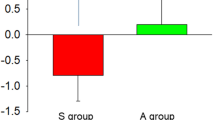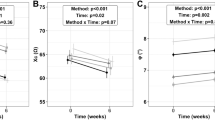Abstract
Objective:
To assess the variation in whole-body and segmental bioelectrical impedance measured in the standing position over the course of a day.
Subjects:
Sixteen healthy men aged 29.6±3.1 years participated in this study.
Measurement:
Impedance between the hands (ZH–H), the feet (ZF–F), and the both hands and feet (ZH–F) was measured using a bioelectrical impedance analysis (BIA) data acquisition system at 500 μA and 50 kHz. Body weight, ZH–H, ZF–F and ZH–F were measured every 3 h from 0900 to 1800.
Results:
Body weight was slightly, but significantly, changed at 1200 (−0.4±0.4 kg, P<0.05), 1500 (+0.4±0.3 kg, P<0.05) and 1800 (−0.2±0.2 kg, P<0.05) compared to their respective previous measurement values. ZH–H significantly increased (P<0.05) and ZF–F significantly decreased (P<0.05) over the course of a day. The mean changes in impedance from 0900 to 1800 were +27.2 Ω (ZH–H) and −31.8 Ω (ZF–F), respectively. There were no changes in ZH–H at 1500 and in ZF–F at 1800 compared to their respective previous measurement values. The ZH–F value did not change significantly between 0900 and 1800.
Conclusion:
Although changes in standing whole-body impedance during the day are small, arm and leg segmental impedance measurements change significantly. Therefore, it is necessary to measure the impedance at regularly scheduled times when evaluating whole-body %fat or body water content using the segmental BIA method.
This is a preview of subscription content, access via your institution
Access options
Subscribe to this journal
Receive 12 print issues and online access
$259.00 per year
only $21.58 per issue
Buy this article
- Purchase on Springer Link
- Instant access to full article PDF
Prices may be subject to local taxes which are calculated during checkout

Similar content being viewed by others
References
Baumgartner RN, Chumlea WC, Roche AF (1990). Bioelectric impedance for body composition. Exerc Sport Sci Rev 18, 193–224.
Bedogni G, Malavolti M, Severi S, Poli M, Mussi C, Fantuzzi AL et al. (2002). Accuracy of an eight-point tactile-electrode impedance method in the assessment of total body water. Eur J Clin Nutr 56, 1143–1148.
Bracco D, Thiebaud D, Chiolero RL, Landry M, Burckhardt P, Schutz Y (1996). Segmental body composition assessed by bioelectrical impedance analysis and DEXA in humans. J Appl Phyiol 81, 2580–2587.
Deurenberg P, Andreoli A, Borg P, Kukkonen-Harjula K, Lorenzo A, Lichtenbelt WM et al. (2001). The validity of predicted body fat percentage from body mass index and from impedance in samples of five European populations. Eur J Clin Nutr 55, 973–979.
Deurenberg P, Weststrate JA, Paymans I, Kooy K (1988). Factors affecting bioelectrical impedance measurement in humans. Eur J Clin Nutr 42, 1017–1022.
Gallagher MR, Walker KZ, O'Dea K (1998). The influence of a breakfast meal on the assessment of body composition using bioelectrical impedance. Eur J Clin Nutr 52, 94–97.
Gibson AL, Heyward VH, Mermier CM (2000). Predictive accuracy of Omron Body Logic analyzer in estimating relative body fat of adults. Int J Sports Nutr Exerc Metab 10, 216–227.
Lukaski HC, Johnson PE, Bolonchuck WW, Lykken GE (1985). Assessment of fat free mass using bioelectrical impedance measurement of the human body. Am J Clin Nutr 41, 810–817.
Malavolti M, Mussi C, Poli M, Fantuzzi AL, Salvioli G, Battistini N et al. (2003). Cross-calibration of eight-polar bioelectrical impedance analysis versus dual-energy X-ray absorptiometry for the assessment of total and appendicular body composition in healthy subjects aged 21–82 years. Ann Hum Biol 30, 380–391.
Miyatani M, Kanehisa H, Masuo Y, Ito M, Fukunaga T (2001). Validity of estimating limb muscle volume by bioelectrical impedance. J Appl Physiol 91, 386–394.
Nunez C, Gallagher D, Visser M, Pi-Sunyer FX, Wang ZM, Heymsfield SB (1997). Bioimpedance analysis: evaluation of leg-to-leg system based on pressure contact foot-pad electrodes. Med Sci Sports Exerc 29, 524–531.
Organ LW, Bradham GB, Gore DT, Lozier SL (1994). Segmental bioelectrical impedance analysis: theory and application of a new technique. J Appl Phyiol 77, 98–112.
Schell B, Gross R (1987). The reliability of bioelectrical impedance measurements in the assessment of body composition in healthy adults. Nutr Rep Int 36, 449–459.
Segal KR, Van Loan M, Fitzgerald PI, Hodgdon JA, Van Itallie TB (1988). Lean body mass estimation by bioelectrical impedance analysis: a four-site cross-validation study. Am J Clin Nutr 47, 7–14.
Seo A, Kakehashi M, Tsuru S, Yoshinaga F (1996). Leg swelling during continuous standing and sitting work without restricting leg movement. J Occup Health 38, 186–189.
Slinde F, Bark A, Jansson J, Rossander-Hulthen L (2003). Bioelectrical impedance variation in healthy subjects during 12 h in the supine position. Clin Nutr 22, 153–157.
Slinde F, Rossander-Hulthen L (2001). Bioelectrical impedance: effect of 3 identical meals on diurnal impedance variation and calculation of body composition. Am J Clin Nutr 74, 474–478.
Wagner DR, Heyward VH (1999). Techniques of body composition assessment: a review of laboratory and field methods. Res Quart Exerc Sport 70, 135–149.
Winkel J (1981). Swelling of the lower leg in sedentary work – a pilot study. J Hum Ergol 10, 139–149.
Xie X, Kolthoff N, Barenholf O, Nielsen SP (1999). Validation of a leg-to-leg bioimpedance analysis system in assessing body composition in post-menopausal women. Int J Obes Relat Metab Disord 23, 1079–1084.
Acknowledgements
We thank the operators of the Sakazaki Clinic for their help with the DXA examinations. We also thank all the subjects for their participation in the study.
Author information
Authors and Affiliations
Corresponding author
Additional information
Guarantor: Y Oshima.
Contributors: Both authors took part in data collection and/or analysis and contributed to the final version of the manuscript.
Rights and permissions
About this article
Cite this article
Oshima, Y., Shiga, T. Within-day variability of whole-body and segmental bioelectrical impedance in a standing position. Eur J Clin Nutr 60, 938–941 (2006). https://doi.org/10.1038/sj.ejcn.1602402
Received:
Revised:
Accepted:
Published:
Issue Date:
DOI: https://doi.org/10.1038/sj.ejcn.1602402
Keywords
This article is cited by
-
Effects of procedure, upright equilibrium time, sex and BMI on the precision of body fluid measurements using bioelectrical impedance analysis
European Journal of Clinical Nutrition (2018)
-
Predicting body composition using foot-to-foot bioelectrical impedance analysis in healthy Asian individuals
Nutrition Journal (2015)
-
Time course of supine and standing shifts in total body, intracellular and extracellular water for a sample of healthy adults
European Journal of Clinical Nutrition (2015)
-
The effect of a meal on measures of impedance and percent body fat estimated using contact-electrode bioelectrical impedance technology
European Journal of Clinical Nutrition (2013)
-
A comparison of dual energy X-ray absorptiometry and bioelectrical impedance analysis to measure total and segmental body composition in healthy young adults
European Journal of Applied Physiology (2012)



